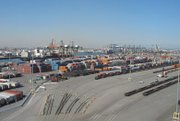Security and Technology Top Bill at AAFA Conference in Long Beach
Apparel and footwear manufacturers at the International Sourcing, Customs, Logistics Integration Conference—held March 27–28 in Long Beach, Calif.—were assured that if the country goes to a “code red” security status, the ports at Los Angeles and Long Beach will remain open.
“I want to allay any concerns about port closings,” said Jayson P. Ahern, assistant commissioner for the Office of Field Operations at U.S. Customs, which is now part of the Homeland Security Department. “There have been no port closings and none anticipated.”
Organized by the American Apparel & Footwear Association (AAFA), the conference addressed new security requirements for imported goods, new technology that will help identify those goods and overseas manufacturing.
The recently enacted Customs–Trade Partnership Against Terrorism (C–TPAT) requirements for importers were a major subject of discussion. Under the government requirements, importers must know the entire source of their supply chain—from overseas factories to agents and ocean carriers— to get goods through U.S. Customs quickly.
Ahern noted that there are now 2,300 firms in the United States that are C–TPAT members, including 60 of the top 100 U.S. importers and 30 of the 50 largest ocean carriers.
The Container Security Initiative, which requires that importers file detailed cargomanifest information electronically with U.S. Customs at least 24 hours before shipping goods on vessels bound for the United States, was also addressed at the conference.
“We hope to expand this to our southern borders by the end of the year, but there are a different set of challenges there,” Ahern said, noting that the 24-hour rule may have to be reduced to 12 hours when it comes to trucking goods from Mexico and other points south of the United States.
The challenge of overseas manufacturing was another topic discussed at the conference. Several apparel and footwear companies shared their problems with and their solutions to having products produced in other countries.
Jerry Turner, president of American Sporting Goods Co. in Ir vine, Calif., shared his worst-case scenario, which involved manufacturing footwear in the Dominican Republic.
“I went through three revolutions,” he said.
He recalled asking his general manager to speak up when relaying the news about one revolution.
“He said, ’I can’t—there’s a mob going through the factory right now, and there are 55-gallon drums ringed around the factory,’” Turner remembered. “I told him I didn’t remember drums being on the list of equipment we bought.”
Fortunately, the wounds healed quickly, Turner said. His company, which manufactures footwear including Turntec and Avia athletic shoes, has been manufacturing in China for 20 years.
China will continue to play a dominant role in sourcing as its apparel and textile quotas are expected to be phased out in 2005.
Supply-chain technology
On the technological side of the business, manufacturers and suppliers at the conference learned that new inventions—such as radio-frequency ID (RFID) tags and Internetbased EDI systems—are just around the corner. Unless companies keep up with these advancements, they will be left in the dust, technology executives said.
With leading retailers, including Wal- Mart and Nordstrom, investing more in technology and favoring manufacturers and suppliers that can comply with their needs, apparel suppliers are feeling the pressure more than ever, said conference panelist Marshall Gordon, apparel and footwear manager for supply-chain-management solutions provider SAP America.
Gordon said it is only a matter of time before chains such as Wal-Mart adapt RFID technology, which carries inventory data in tiny chips embedded in garments and tags.
Last month, Italian retailer Benetton said it is integrating such technology into its supply chain. Consumer-goods giant Gillette already has half a billion tags on order, Gordon said.
“Using this technology, you can take inventory in a Victoria’s Secret store in three minutes. The challenge is to be there when it becomes reality,” he explained.
Such technology reflects the trend toward consumer and supply-side solutions, added Cari Bunch, principal with Kurt Salmon Associates in San Bruno, Calif.
“[Technology] is focused on consumer demand and predicated on [retailers, manufacturers and suppliers] sharing data forward and backward,” she said. “Staying flexible is critical.”
As events such as the war in Iraq and last year’s dockworker lockout show on the West Coast, maintaining adaptive tools is vital to survival, said Alan Brooks, president of New Generation Computing in Miami Lakes, Fla.
Systems such as collaboration software, shop-floor monitoring, point-of-sale tracking and other end-to-end systems have helped companies realize growth of 70 percent earnings per share and returns on investment of $1.5 million to $3 million for every $100 million of sourcing invested, Brooks said, citing data from McKenzie Research.
“I used to view the traditional supply chain as a linear model,” said Doug Schwab, vice president of technology for Cumberland, Md.-based Schwab & Co., a childrenswear company founded in 1914. “It’s now a circular supply chain, and any process you can address can minimize chasing the clock. With long lead times, fast-changing styles and product, we don’t have total control over everything any more, so collaboration technology is helping to assign the tasks to get the job done.”






















